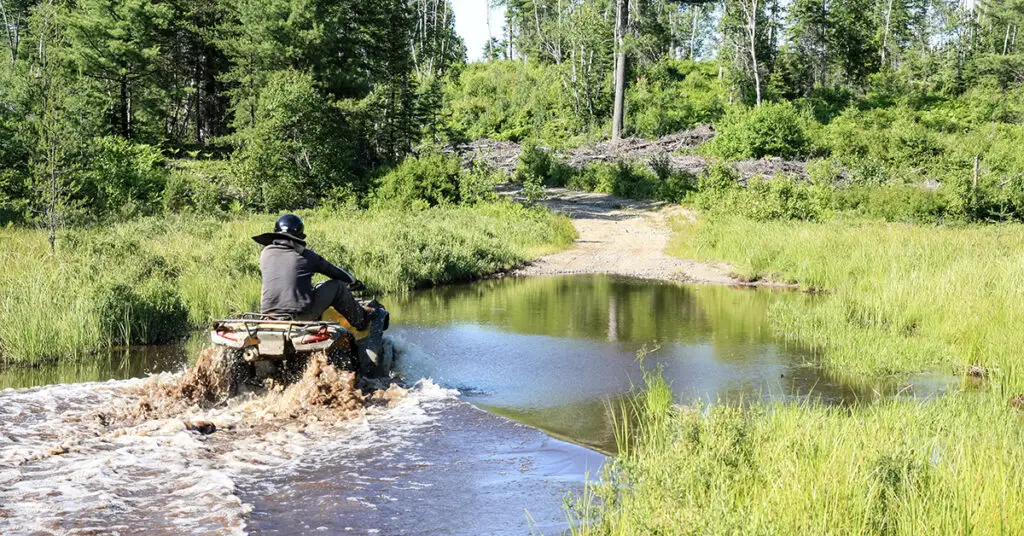ATVs, or all-terrain vehicles, are designed for off-road driving. However, some ATVs have been known to brave watery conditions. Whether or not can ATVs go in the water depends on the make and model of the vehicle.
This is a question that we get asked a lot, and it is one that has a bit of a complicated answer. There are a few things that you need to take into consideration before you take your ATV out onto the water:
- You need to make sure that your ATV is actually designed to be used in water. Some ATVs are not meant to be driven in water at all, and attempting to do so can damage the vehicle. If you are not sure whether or not your ATV can go in the water, it is always best to check with the manufacturer to be sure.
- Once you have confirmed that your ATV can, in fact, be driven in water, you need to take a few precautions. You will want to make sure that you are not driving in too deep of water. If the water is too deep, it can cause your ATV to float away or even sink. Stick to shallow water that is no more than a few feet deep.
- You will want to avoid driving in moving water. This can be extremely dangerous, as the water can sweep your ATV away. If you absolutely must drive in moving water, make sure that you are driving VERY slowly and carefully.
- You will want to avoid driving in water that is too rough. Rough water can damage your ATV, and it can also be dangerous. If the water is too rough, it can cause your ATV to tip over.
Precautions While Taking Your Atvs in Water
We all love our ATVs and enjoy taking them out on the trail, but did you know that you need to take some special precautions when taking your ATVs out on the water? Here are some tips to keep in mind:
- Make sure your ATV is in good working condition before taking it into the water. This means checking the tires, brakes, and other parts of the vehicle to make sure everything is in good condition.
- Do not take your ATV into deeper water than necessary. This can put unnecessary stress on the vehicle and increase the risk of it getting stuck.
- If you do get stuck, do not try to force your way out. This can damage the ATV and make it more difficult to get unstuck. Instead, call for help or try to float the ATV out using a life jacket or other flotation device.
- Be careful of currents when crossing rivers or streams. These can be strong and can quickly carry your ATV away if you are not careful.
- Avoid using your ATV in muddy conditions. This can clog up the engine and make it difficult to move.
If you are looking for the Best ATV Tire For Mud And Trail, then here’s our Guide on this link.
By following these simple tips, you can help ensure that you and your ATV have a safe and enjoyable time out on the water.
Things That Might Happen if You Ride an ATV in Deep Water

Have you ever wondered what would happen if you take your ATV out for a spin in deep water? Well, wonder no more! We have got all the details on what happens when you take your four-wheeler for a swim.
First things first, you should never ride your ATV in deep water unless you are absolutely sure that it is safe to do so. There are a number of dangers that come with riding in deep water, and it is not worth risking your safety to find out what happens.
That being said, if you do find yourself in a situation where you have to ride in deep water, there are a few things you should know.
For starters, it is important to remember that ATVs are not designed to be ridden in water. This means that they can easily become waterlogged if they are ridden in too deep of water.
If your ATV becomes waterlogged, it can be extremely difficult to control. This can lead to you losing control of the ATV and crashing.
Additionally, riding in deep water can also cause your ATV to float away. If you are not careful, you could easily find yourself drifting out to sea!
So, what happens if you do find yourself in deep water on your ATV?
If you are lucky, you will be able to make it to shore without incident. However, if you are not so lucky, you could find yourself in a world of trouble.
If you end up crashing your ATV in deep water, it is important to stay calm. This can be difficult to do, but it is crucial if you want to avoid further injury.
Once you are out of the water, it is important to assess the situation and see if you can move the ATV to safety. If you cannot, then you will need to call for help.
If you are unable to move the ATV, then you should wait for help to arrive. In the meantime, try to keep yourself as calm as possible and avoid moving around too much.
There you have it! That is what happens if you ride your ATV in deep water. Remember, it is always best to avoid riding in water if you can, but if you find yourself in a situation where you have to, then make sure you know what to do.
Things That Can Be Done to Modify an ATV to Go In Water (Can Atvs Go in the Water)

If you are looking for a way to take your ATV off-road and onto the water, there are a few modifications you will need to make. With a few simple changes, you can turn your ATV into a water-going machine.
When it comes to all-terrain vehicles, there are few things more versatile than being able to go in the water. Whether you are looking to cross a river or simply want to take a dip in the lake, being able to modify your ATV to go in water can open up a whole new world of possibilities.
Of course, before you start making any modifications, it is important to make sure that your ATV is actually designed to go in the water in the first place. Some models are better equipped for this than others, so it is worth doing your research before you start making any changes.
Assuming your ATV is up to the task, there are a few key modifications you will need to make in order to ensure it can safely and effectively go in the water. Here is a look at what you need to do:
1. Install a Water Pump
The first and arguably most important modification you will need to make is installing a water pump. This will ensure that water can be efficiently pumped through the engine, cooling it down and preventing any damage.
There are a number of different water pumps on the market, so it is worth taking some time to find one that is compatible with your ATV. Once you have found the right model, follow the instructions carefully to ensure it is properly installed.
2. Add a Snorkel
In order for your ATV to be able to go in the water, it will need a snorkel. This will allow air to enter the engine, even when it is submerged, preventing any water from getting in and causing damage.
There are a number of different snorkels on the market, so again, it is important to find one that is compatible with your ATV. Once you have found the right model, follow the instructions carefully to ensure it is properly installed.
3. Install Some Skid Plates
If you are planning on going in deep water, it is also a good idea to install some skid plates. These will protect the underside of your ATV from any rocks or other obstacles that you might encounter.
There are a number of different skid plates on the market, so once again, it is important to find ones that are compatible with your ATV. Once you have found the right models, follow the instructions carefully to ensure they are properly installed.
4. Get Some Waterproofing
It is a good idea to get your ATV waterproofed. This will help to protect it from any water that might get inside, whether it is from rain or from crossing a river.
There are a number of different waterproofing products on the market, so it is worth taking some time to find one that is compatible with your ATV. Once you have found the right product, follow the instructions carefully to ensure it is properly applied.
Making these modifications will ensure that your ATV can safely and effectively go in the water. Just be sure to take your time and do your research before making any changes, and always follow the instructions carefully to avoid any potential problems.




